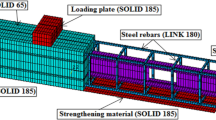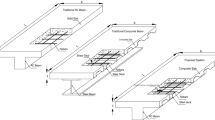Abstract
In order to investigate the mechanical performance and load carrying capacity of continuous steel-concrete composite beams with web openings, five continuous composite beams with web openings and a contrasting continuous composite beam without web openings were tested through two symmetric point loads. Nonlinear finite element analysis was also conducted, in which the slab thickness and the reinforcement ratio of slabs were selected as the major parameters. The main results of this test were concluded as follows: (1) Web openings not only decrease the stiffness and ultimate load carrying capacity of continuous composite beams but also give rise to the redistribution of vertical shear force between the cross section of the steel beam and the concrete slab at the web opening region. (2) The plane hypothesis is not satisfied at the web opening region. The failure mode of continuous composite beams with web openings is the shear failure of concrete slab in the region near the opening, and the result also indicates that the shear bearing capacity at the span with web openings become a critical factor in controlling design. (3) Meanwhile, by increasing the thickness and reinforcement ratio of a concrete slab, the ultimate load carrying capacity and ductility of continuous composite beams increased, which can be used to the enhancement of web opening region. (4) In addition, based on the experimental results, a finite element mode was established for composite beams with web openings, and good agreement was obtained between the tested results and the numerical results.
Similar content being viewed by others
References
AISC (1994). Load and resistance factor design specifications for structural steel buildings. American Institute of Steel Construction, Chicago, USA.
Chen, T., Gu, X. L., and Li, H. (2011). “Behavior of steelconcrete composite cantilever beams with web openings under negative moment.” International Journal of Steel Structures, 11 (1), pp. 39–49.
Clawson, W. C. and Darwin, D. (1982a). “Tests of composite beams with web openings.” Journal of the Structural Division, 108 (1), pp. 145–162.
Clawson, W. C. and Darwin, D. (1982b). “Strength of composite beams at web openings.” Journal of the Structural Division, 108 (3), pp. 623–641.
Cho, S. H. and Redwood, R. G. (1992a). “Slab behavior in composite beams at openings. II: Tests and Verification.” Journal of Structural Engineering, ASCE, 118 (9), pp. 2304–2322.
Cho, S. H. and Redwood, R. G. (1992b). “Slab behavior in composite beams at openings. I: Analysis.” Journal of Structural Engineering, ASCE, 118 (9), pp. 2287–2303.
Darwin, D. and Lucas, W. K. (1990). “LRFD for steel and composite beams with web openings.” Journal of Structural Engineering, ASCE, 116 (6), pp. 1579–1593.
Darwin, D. and Donahey, R. C. (1988). “LRFD for composite beams with unreinforced web openings.” Journal of Structural Engineering, ASCE, 114 (3), pp. 535–552.
Darwin, D. (1990). Steel and composite beams with web openings: design of steel and composite beams with web openings. American Institute of Steel Construction, Steel Design Guide Series No. 2. Chicago, USA.
Soon, H. C. and Redwood, R. G. (1992). “Slab behavior in composite beams at openings I: analysis.” Journal of Structural Engineering, 118 (9), pp. 2287–2302.
Eurocode 4 (1994). Design of composite steel and concrete structures. Part 1:General rules and rules for buildings. European Committee for Standardization, Brussels, Belgium.
GB 50017 (2003). Code for design of steel structures. China Planning Press, Beijing, China. (in Chinese)
Li, H., Chen, T., and Gu, X. L. (2008). “Experimental Study on Behavior of Steel-Concrete Composite Beams with Web Openings under Negative Moment.” Structural Engineers, 24 (4), pp. 99–106 (in Chinese).
Nie, J. G., Chen, L., and Xiao, Y. (2002a). “Plastic analysis of shear behavior of composite steel-concrete beams.” Engineering Mechanics, 19 (5), pp. 48–51. (in Chinese).
Nie, J. G. and Xiao, Y. (2002b). “Composite shear behavior of steel-concrete composite beams under sagging moment.” Journal of Tsinghua university(science and technology), 42 (6), pp. 835–838. (in Chinese).
Narayanan, R., Al-Amery, R., and Roberts, T. (1989). “Shear strength of composite plate girders with rectangular web cut-outs.” Journal of constructional steel research, 12 (2), pp. 151–166.
Redwood, R. and Cho, S. H. (1993). “Design of steel and composite beams with web openings.” Journal of Constructional Steel Research, 25 (1), pp. 23–41.
Redwood, R. G. and Wong, P. K. (1982). “Web holes in composite beams with steel deck.” Proc. 8th Canadian Structural Engineering Conf., Canadian Steel Construction Council, Canada, 41.
Redwood, R. G. and Poumbouras, G. (1983). “Tests of composite beams with web holes.” Canadian Journal of Civil Engineering, 10 (4), pp. 713–721.
Wang, P., Zhou, D. H., Wang, Y. H., and Han, C. X. (2013). “Theoretical study on ultimate bearing capacity of composite beams with reinforced web openings.” Engineering Mechanics, 30 (5), pp. 138–146.
Zhou, D. H. (2003a). “Ein Rechenverfahren für Verbundträgern mit StegöffnungenTeil 1.” Stahlbau, 72 (9), pp. 626–634. (in German)
Zhou, D. H. (2003b). “Ein Rechenverfahren von Verbundträgern mit StegöffnungenTeil 2.” Stahlbau, 272 (10), pp. 744–747. (in German).
Hognestad, E. and Hanson, N. W. (1995). “Concrete stress distribution in ultimate strength design.” ACI Journal, Proceedings, 52 (4), pp. 455–479.
Ollgaard, H. G., Slutter, R. G., and Fisher, J. D. (1971). “Shear strength of stud connectors in lightweight and normal-weight concrete.” Engineering Journal of American of Steel Construction, 8 (2), pp. 55–64.
Author information
Authors and Affiliations
Corresponding author
Rights and permissions
About this article
Cite this article
Li, L., Liao, W., Wang, J. et al. Behavior of continuous steel-concrete composite beams with web openings. Int J Steel Struct 15, 989–997 (2015). https://doi.org/10.1007/s13296-015-1218-2
Received:
Accepted:
Published:
Issue Date:
DOI: https://doi.org/10.1007/s13296-015-1218-2




